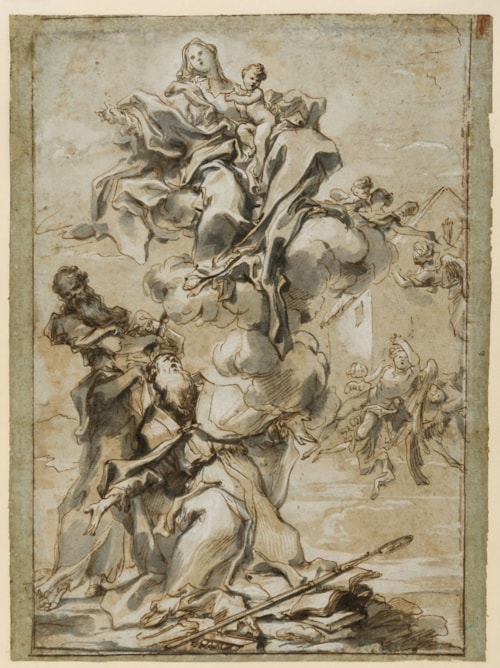
Gregorio DE FERRARI
Porto Maurizio 1647 - Genoa 1726
Biography
The work of Gregorio de Ferrari, and in particular his large-scale fresco decorations, occupies an important position as one of the high points of the Genoese Baroque tradition. Abandoning his law studies, he trained as an artist in the studio of Domenico Fiasella in Genoa between 1664 and 1668 before going to Parma, where his exposure to the work of Correggio was to have a profound and lifelong influence on his style. Returning to Genoa around 1673, he began a long and prolific series of collaborations with Domenico Piola, then the leading painter in Genoa, whose daughter he married in 1674. The two artists worked together on a number of decorative projects in Genoa and its outskirts, notably in the Palazzo Rosso and the churches of San Siro and San Giovanni Battista in Sampierdarena. (Both painters were particularly busy with large-scale interior decorations in numerous palaces in Genoa following the bombardment of the city by French naval forces in May 1684.) Much of De Ferrari’s career was taken up with fresco decorations for various churches and palaces in Genoa and elsewhere in the region, although he also produced a number of easel pictures, as well as designs for silver objects and sculpture.
As has been noted of the artist, ‘Whether in a drawing, fresco or canvas, De Ferrari’s style is unmistakable – free flowing, exploratory, and such an anticipation of the rococo that one critic deemed him “a grander Fragonard”, though that Frenchman would not be born until 1732, six years after the death of the Genoese master.’ Among De Ferrari’s most significant works in Genoa are frescoes in the Villa Balbi allo Zerbino, the Palazzo Brignole and the Palazzo Rosso, as well as the vast Assumption of the Virgin on the nave vault of the Dominican church of Santi Giacomo e Filippo, completed around 1690 and destroyed during the Second World War. His reputation as one of the finest fresco painters of the Seicento also spread outside Liguria, and in 1685 he was commissioned by Vittorio Amedeo of Savoy to fresco several rooms in the Palazzo Reale in Turin, while in 1692 he is recorded as working for the French nobleman Jacques de Noailles in Marseille, although nothing of his work there survives. Around 1700 he painted a monumental altarpiece of The Death of Saint Scholastica for the church of Santo Stefano that is regarded as one of his finest religious pictures. De Ferrari’s last public commission was the decoration of the cupola of the Genoese church of Santa Croce e San Camillo, a project eventually completed by his son Lorenzo de Ferrari.
Gregorio de Ferrari is relatively rare as a draughtsman, and the largest surviving group of his drawings is today in the Gabinetto Disegni e Stampe in the Palazzo Rosso in Genoa. As Jonathan Bober has recently noted of the artist, ‘On the one hand, Gregorio was the most idiosyncratic and palpably willful draftsman of the era. On the other, of all Genoese, including even the extraordinarily prolific Domenico Piola, he appears to have been the most complete. A relatively small number of his drawings survives – perhaps one hundred, most in the collection of the Palazzo Rosso. That they represent every possible mode, stage, technique, and function only proves there has been tremendous attrition.’ A typical feature of De Ferrari’s draughtsmanship, at least in the first part of his career, is a preference for prepared coloured paper, as well as a liberal use of white heightening. Unlike many of his Genoese contemporaries, he does not seem to have produced many drawings as independent works of art, while at the same time only a handful of the surviving drawings by the artist can be specifically connected with any of his known works.


